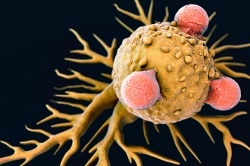 |
| Illustration of T lymphocytes on a cancer cell--Courtesy of MIT |
MIT's Dane Wittrup, one of the scientific founders behind Eleven Biotherapeutics, says he and a trio of grad students have developed some significant new insights into amping up the performance of cancer immunotherapies.
Like others before him, Wittrup says he was experimenting with ways to improve the performance of antibody drugs with the signaling molecule IL-2. While combining antibodies and IL-2 has worked well in the lab dish against cancer cells, kidneys can be counted on to flush IL-2 within an hour of being injected into the blood.
To prevent the flushing, Wittrup and his team fused antibodies with IL-2 and demonstrated its effectiveness in mice engineered to suffer from a particularly aggressive form of melanoma, or skin cancer. Once-weekly treatments of their fusion therapy stopped tumor growth, according to the scientist.
The reason it worked so well, they add, is that the fusion process helped recruit T cells to attack the cancer, creating an environment that improved the efficiency of the T-cell attack.
"The antibody-driven innate response creates an environment such that when the T cells come in, they can kill the tumor. In its absence, the tumor cells establish an environment where the T cells don't work very well," Wittrup says in a statement.
Targeted T cells were more effective in this immunotherapy. And another observation: Neutrophils provided a surprisingly significant assist.
"They're a really powerful force in your immune system, but people in immunotherapy don't usually focus on neutrophils. They don't really consider them as a viable tool," grad student Eric Zhu says. "It pointed us to the idea that although T cells and natural killer cells are important, maybe we're forgetting about a part of the immune system that is also really important and could help us achieve our goals of ultimately curing the tumors."
Their work was published in the journal Cancer Cell.
- here's the release
- read the research abstract